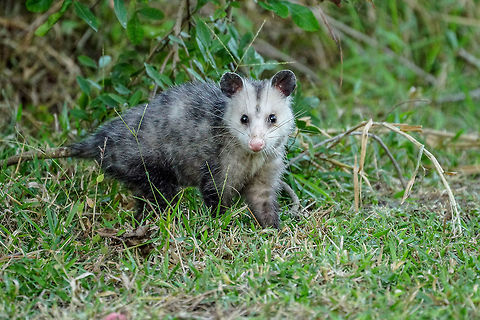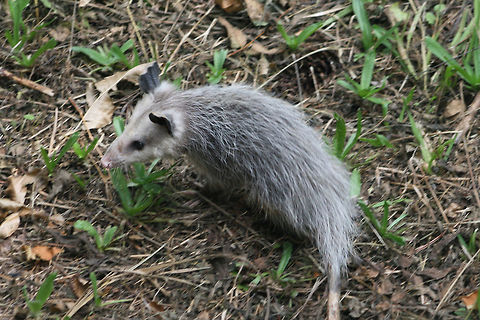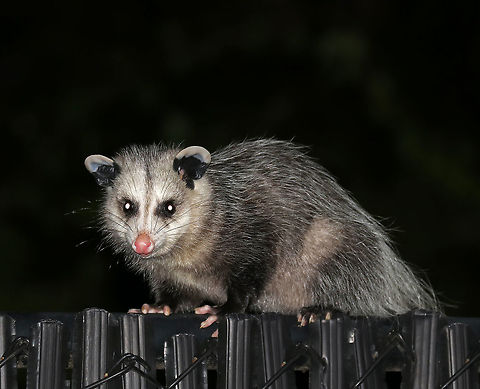
Appearance
Virginia opossums can vary considerably in size, with larger specimens found to the north of the opossum's range and smaller specimens in the tropics. They measure 13–37 inches long from their snout to the base of the tail, with the tail adding another 8.5–19 inches.Weight for males ranges from 1.7 to 14 pounds and for females from 11 ounces to 8.2 pounds. They are one of the world's most variably sized mammals, since a large male from northern North America weighs about 20 times as much as a small female from the tropics.
Their coats are a dull grayish brown, other than on their faces, which are white. Opossums have long, hairless, prehensile tails, which can be used to grab branches and carry small objects. They also have hairless ears and a long, flat nose. Opossums have 50 teeth, more than any North American mammal, and opposable, clawless thumbs on their rear limbs.
Opossums have thirteen nipples, arranged in a circle of twelve with one in the middle.
Perhaps surprisingly for such a widespread and successful species, the Virginia opossum has one of the lowest encephalization quotients of any marsupial. Its brain is 5 times smaller than that of a raccoon.

Naming
The Virginia opossum is the original animal named "opossum". The word comes from Algonquian "wapathemwa" meaning "white animal". Colloquially, the Virginia opossum is frequently called simply "possum". The name is applied more generally to any of the other marsupials of the Didelphimorphia and Paucituberculata orders, which includes a number of opossum species in South America.The generic name is derived from Ancient Greek: "di", "two", and "delphus", "womb".
The possums of Australia, whose name is derived from a similarity to the Virginia opossum, are also marsupials, but of the order Diprotodontia.
The Virginia opossum is known in Mexico as "tlacuache", "tacuachi" and "tlacuachi", from the Nahuatl word "tlacuatzin".

Behavior
The Virginia opossum is noted for reacting to threats by feigning death. This is the genesis of the term "playing possum", which means pretending to be dead or injured with intent to deceive. In the case of the opossum, the reaction seems to be involuntary, and to be triggered by extreme fear.It should not be taken as an indication of docility, for under serious threat, an opossum will respond ferociously, hissing, screeching, and showing its teeth. But with enough stimulation, the opossum will enter a near coma, which can last up to four hours. It lies on its side, mouth and eyes open, tongue hanging out, emitting a green fluid from its anus whose putrid odor repels predators. Besides discouraging animals that eat live prey, playing possum also convinces some large animals that the opossum is no threat to their young.
The Virginia opossum does not hibernate, although it may remain sheltered during cold spells.

Food
Opossums are omnivorous and eat a wide range of plants and animals such as fruits, insects, snakes, and other small animals. The Virginia opossum has been found to be very resistant to snake venom. Persimmons are one of the opossum's favorite foods during the autumn. Opossums in captivity are known to engage in cannibalism, though this is probably uncommon in the wild. Placing an injured opossum in a confined space with its healthy counterparts is inadvisable.References:
Some text fragments are auto parsed from Wikipedia.